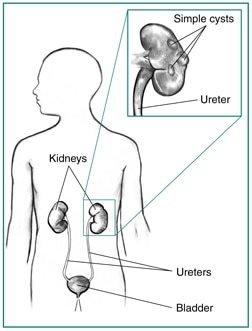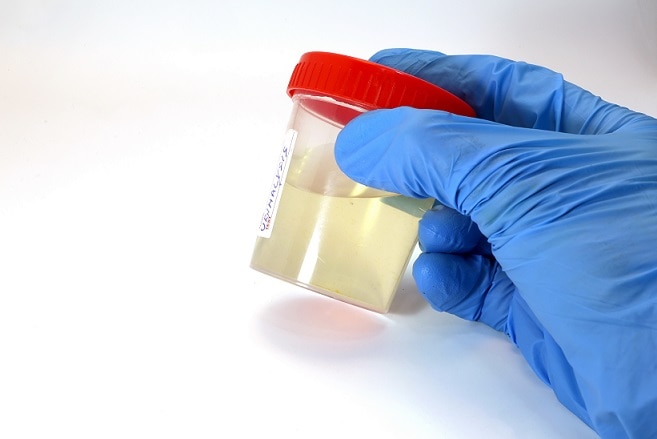Simple Kidney Cysts
On this page:
- What are simple kidney cysts?
- How common are simple kidney cysts?
- Who is more likely to develop simple kidney cysts?
- What are the symptoms and complications of simple kidney cysts?
- What causes simple kidney cysts?
- How do health care professionals diagnose simple kidney cysts?
- How do health care professionals treat the complications of simple kidney cysts?
- Clinical Trials
What are simple kidney cysts?
Simple kidney cysts are fluid-filled sacs, or cysts, that can form in one or both of your kidneys. You can have just one cyst or you can have many. Simple kidney cysts are usually round or oval in shape. They can range from the size of a pea to the size of a golf ball.
Simple kidney cysts are usually harmless. Simple kidney cysts don’t enlarge the kidneys, replace their normal structure, or cause reduced kidney function like cysts do in people with polycystic kidney disease (PKD). PKD is a genetic disorder that can cause chronic kidney disease.
Do simple kidney cysts have another name?
Health care professionals sometimes call them simple renal cysts.

How common are simple kidney cysts
In one large study, about 1 in 10 people had simple kidney cysts. In people age 50 and older, nearly 1 in 5 people had simple kidney cysts.1
Who is more likely to develop simple kidney cysts?
Simple kidney cysts are more common in older people, and men are more likely to develop simple kidney cysts than women.2 In one study, men were twice as likely to have simple kidney cysts.1
What are the symptoms and complications of simple kidney cysts?
As people age, simple kidney cysts tend to grow bigger and grow in number. However, simple kidney cysts usually don’t cause symptoms or additional health problems.
In rare cases, simple kidney cysts can become large enough to
- press on your bones or other organs, causing pain or discomfort
- block blood or urine flow through the kidneys or the ureters
- become infected, causing fever, pain, and tenderness
- burst, causing pain or blood in the urine, also called hematuria
- cause high blood pressure
Talk with your health care professional if you have any of these symptoms. Health care professionals can treat simple kidney cysts that cause symptoms or other health problems.
What causes simple kidney cysts?
Experts don’t fully understand the cause of simple kidney cysts, but they’re more common as people age.
How do health care professionals diagnose simple kidney cysts?
Simple kidney cysts usually don’t cause symptoms, so health care professionals often find simple kidney cysts when they are performing an imaging test for another reason. Health care professionals may use imaging tests and lab tests to rule out other, more serious problems, including some kidney cancers. If you are diagnosed with a simple kidney cyst, you usually don’t need further testing or treatment.
Imaging tests
A specially trained technician performs imaging tests at a health care professional’s office, an outpatient center, or a hospital, and a radiologist or nephrologist reviews the images. A health care professional may use a computed tomography (CT) scan or magnetic resonance imaging (MRI) if he or she needs more information to confirm your diagnosis.
You don’t need anesthesia for these tests, but a health care professional may give you light sedation if you have a fear of small spaces and need an MRI.
Ultrasound. An abdominal ultrasound can find simple kidney cysts by creating images of your kidneys. Ultrasound uses a device called a transducer, which bounces safe, painless sound waves off your organs to create an image or picture of their structure.
CT scan. CT scans can show cysts and tumors in the kidneys. A CT scan uses a combination of x-rays and computer technology to create images of your urinary tract. Although a CT scan without contrast medium is the most common way to view your urinary tract, a health care professional may give you an injection of contrast medium. Contrast medium is a dye or other substance that makes structures inside your body easier to see during imaging tests. For a CT scan, you’ll lie on a table that slides into a tunnel-shaped device that takes the x-rays.
MRI. Like CT scans, an MRI can show cysts and tumors but provides more detailed pictures. MRI machines use radio waves and magnets to produce detailed images of your organs and soft tissues without x-rays.
Lab tests
A health care professional may use urine and blood tests to test your kidney function.
 If you are at risk for kidney problems, you may have additional urine and blood tests.
If you are at risk for kidney problems, you may have additional urine and blood tests.How do health care professionals treat the complications of simple kidney cysts?
Health care professionals usually don’t treat simple kidney cysts that aren’t causing symptoms. However, you may be asked to have regular ultrasounds to watch your simple kidney cysts for signs of change or problems.
Health care professionals will treat simple kidney cysts that cause symptoms, such as pain, or that block the flow of blood or urine. Some studies suggest that draining or removing the cysts may help with high blood pressure related to simple kidney cysts.3 Researchers are not exactly sure how or why this works.
Sclerotherapy. Sclerotherapy is used to drain cysts. Using ultrasound as a guide, a health care professional inserts a long needle through your skin and into the cyst. The health care professional drains the cyst and injects an alcohol solution. The solution hardens the area inside the cyst so it’s less likely to fill with fluid again. This procedure is usually performed at an outpatient center using local anesthesia.
Surgery. If a cyst is large, you may need laparoscopic surgery. The surgeon drains the cyst and then removes or burns away its outer tissue. For this procedure, you may need general anesthesia in a hospital. You may need to stay in the hospital for 1 or 2 days.
Can I prevent simple kidney cysts?
No. You can’t prevent simple kidney cysts.
Clinical Trials for Simple Kidney Cysts
The National Institute of Diabetes and Digestive and Kidney Diseases (NIDDK) and other components of the National Institutes of Health (NIH) conduct and support research into many diseases and conditions.
What are clinical trials, and are they right for you?
Clinical trials are part of clinical research and are at the heart of all medical advances. Clinical trials look at new ways to prevent, detect, or treat disease. Researchers also use clinical trials to look at other aspects of care, such as improving the quality of life for people with chronic illnesses. Find out if clinical trials are right for you.
What clinical trials are open?
Clinical trials that are currently open and are recruiting can be viewed at ClinicalTrials.gov.
References
This content is provided as a service of the National Institute of Diabetes and Digestive and Kidney Diseases
(NIDDK), part of the National Institutes of Health. NIDDK translates and disseminates research findings to increase knowledge and understanding about health and disease among patients, health professionals, and the public. Content produced by NIDDK is carefully reviewed by NIDDK scientists and other experts.

